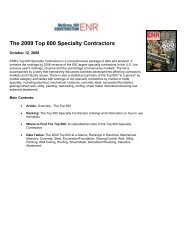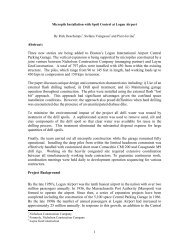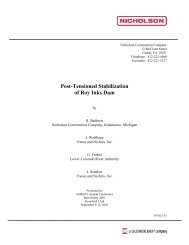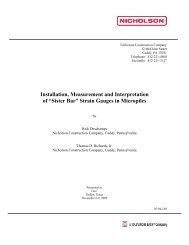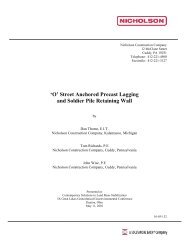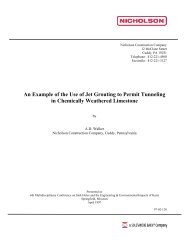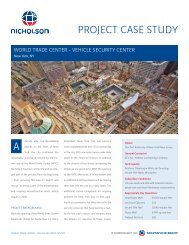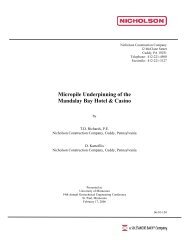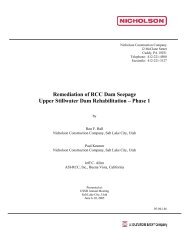Rehabilitation of a Failing Anchored Retaining Wall - Nicholson ...
Rehabilitation of a Failing Anchored Retaining Wall - Nicholson ...
Rehabilitation of a Failing Anchored Retaining Wall - Nicholson ...
You also want an ePaper? Increase the reach of your titles
YUMPU automatically turns print PDFs into web optimized ePapers that Google loves.
Richards/Thome, Page 3<br />
3. Lack <strong>of</strong> corrosion protection on the initial thread bars used as tieback supports.<br />
Conclusions <strong>of</strong> the study suggested that while each defect in the wall is believed to be a<br />
contributing factor in the failure, the combination <strong>of</strong> all three factors acting simultaneously<br />
probably initiated the global failure. Improper drainage from behind the wall increased the<br />
earth pressures acting on the wall leading to overload the tiebacks, failing in part due to the<br />
lack <strong>of</strong> sufficient corrosion protection around the ground anchors. Finally, subsurface<br />
investigations concluded that the toe <strong>of</strong> the slurry wall was actually embedded in a stratum <strong>of</strong><br />
slickensided clay, which created a less resistant path for the failure plane.<br />
Condition <strong>of</strong> Old Anchors<br />
Bar anchors were installed in 1978. As noted above, the bearing plates and nuts reportedly<br />
exhibited problems during testing. By 1999, several <strong>of</strong> the anchors had failed causing the<br />
wall to lean significantly. Detailed condition assessment <strong>of</strong> the anchors was not a component<br />
<strong>of</strong> our work, since the rehabilitation did not rely on any <strong>of</strong> the existing anchors.<br />
As part <strong>of</strong> demolition <strong>of</strong> leaning wall panels, several anchors were exhumed. The breaks were<br />
typically within the wall or just behind the wall as shown in Photos 3 and 4. The pipe was a<br />
typical anchor sleeve in the diaphragm wall.<br />
Photo 3 Breaks in Anchors behind <strong>Wall</strong><br />
Photo 4 Breaks in Anchors behind <strong>Wall</strong><br />
Grouting <strong>of</strong> the sleeves seemed to have some deficiencies as shown in Photos 3 and 4 and also<br />
several <strong>of</strong> the other anchors which had seepage and grass growing around the bearing plates.<br />
It is also unclear how access for secondary grouting was provided.<br />
The broken bar had pitting corrosion and had been protected by plastic sheath as shown in<br />
Photo 5. It did not appear that grease had been used or remained inside the plastic sheath.<br />
Water could then get to the bars through the incomplete secondary grouting and then travel<br />
down the bar. However, the bars would then have been expected to fail near the top. This<br />
suggests that shear loads may have also been present at the back face <strong>of</strong> wall to ground<br />
interface due to possible filling behind the wall or lateral wall movement allowing downward<br />
soil movement behind the wall.



